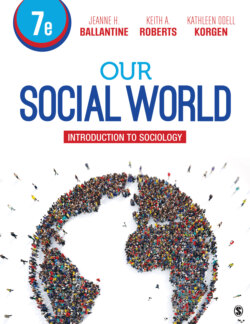Читать книгу Our Social World - Kathleen Odell Korgen - Страница 45
На сайте Литреса книга снята с продажи.
Why Study Sociology?
ОглавлениеThe sociological perspective helps us to be more effective as we carry out our roles as life partners, workers, friends, family members, and citizens. For example, an employee who has studied sociology may better understand how to work with groups and how the structure of the workplace affects individual behavior, how to approach problem-solving, and how to collect and analyze data. Likewise, a schoolteacher trained in sociology may have a better understanding of classroom management, student motivation, the causes of poor student learning that have roots outside the school, and why students drop out. Consider the example in the following Sociology in Our Social World feature, which explores who drops out, why, the consequences of dropping out, and other variables that shape the professional life of teachers and academic success of students.
Sociology in Our Social World
High School Dropouts: Causes, Consequences, and Cures
“Cesar entered Hacienda Middle School in the Los Angeles School District in the sixth grade. He lived with his mother and three younger siblings in a garage that was divided into sleeping quarters and a makeshift kitchen with no running water. His mother, who spoke only Spanish, supported the family by working long hours at a minimum-wage job” (Rumberger 2011:1). Because Cesar missed lots of school and did not complete assignments, he failed the first quarter. However, a dropout prevention program helped him begin to pass courses. By eighth grade peer pressure and gangs became part of his life. He was involved in a fight in school and was “transferred”—but stopped going to school. Cesar became a dropout (Rumberger 2011).
Sociologists studying education look for causes and results of students dropping out versus staying in school. Dropouts are defined as “16- through 24-year-olds who are not enrolled in school and have not earned a high school credential (either a diploma or an equivalency credential such as a GED certificate)” (National Center for Education Statistics 2017a). The percentage of high school dropouts has decreased from 12% in 1990 to approximately 6% in 2017. The decline for White students was from 9% to 5%, for Blacks from 13% to 7%, and for Hispanics from 32% to 12%. This narrowed the gap between White and Hispanic students by 23% (McFarland, Stark, and Cui 2018; U.S. Department of Education 2015). The U.S. dropout rate is currently at an all-time low due to improvements in graduation rates to 84.1% overall and lower dropout rates for students of color, low-income students, English language learners, and students with disabilities (America’s Promise Alliance 2018).
Yet sociologists, educators, parents, and policymakers, among others, are concerned about dropout rates because of economic factors—dropouts have difficulty finding jobs, pay fewer taxes, and often receive public assistance. If they do find a job, they earn about $8,000 a year less than high school graduates and $26,500 a year less than college graduates (Alliance for Excellent Education 2018). Unemployment rates for dropouts are 7.7% compared to 2.5% for college graduates (Bureau of Labor Statistics 2017c). Dropouts have poorer health, use more health services, and die younger. They also are more likely to engage in criminal behavior and spend time in prison. They are less likely to vote or be engaged in civic activities. Dropouts cost the nation an estimated $1.8 billion every year in lost tax revenue alone (“High School Dropouts Cost $1.8 Billion Every Year” 2013).
Why do students drop out? A few reasons stand out:
High rates of absenteeism
Low levels of school engagement
Low parental education
Work or family responsibilities
Problematic/deviant behavior
Moving to a new school in ninth grade
Attending school with lower achievement scores (Child Trends 2013b)
Sociologists and others propose many solutions for the dropout problem. Dropout counselors can identify students at risk and work with them, finding programs and curricula suited to their needs. Schools designed for at-risk students attempt to address issues in the students’ lives such as living situations, poverty, poor health, lack of nutrition, gang membership, and other barriers to success (Diggs 2014). By understanding the causes of students dropping out we can address the problem (National Dropout Prevention Center/Network 2015).
A sociological perspective allows us to look beneath the surface of society and notice social patterns that others tend to overlook. When you view our social world with a sociological perspective, you
1 become more self-aware by understanding your social surroundings, which can lead to opportunities to improve your life;
2 have a more complete understanding of social situations by looking beyond individual explanations to include group analyses of behavior;
3 understand and evaluate problems more clearly, viewing the world systematically and objectively rather than only in emotional or personal terms;
4 gain an understanding of the many diverse cultural perspectives and how cultural differences are related to behavioral patterns;
5 assess the impact of social policies;
6 understand the complexities of social life and how to study them scientifically;
7 gain useful skills in interpersonal relations, critical thinking, data collection and analysis, problem-solving, and decision-making; and
8 learn how to change your local environment and the larger society.
This book introduces you to most major topics in sociology, as outlined in the sociological literacy framework: the sociological eye (or the sociological imagination); social structure (from micro to macro levels); socialization (the relationship between ourselves and society); stratification (social inequality); and social change and social reproduction (major change processes and how social structures reproduce themselves) (ASA 2017).
